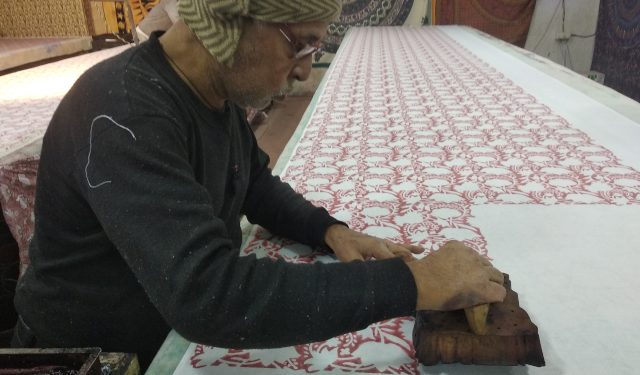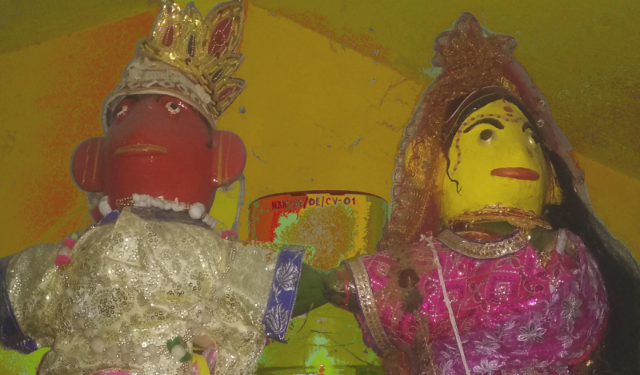Block printing is a way of creating coloured designs on fabric using wooden blocks. The hand block printing process involves block printing craftsmen or women using wooden or sometimes metal blocks that each has a particular pattern carved on them to stamp on plain fabrics. Sometimes several layers of patterns in different colours are printed over each other to create multi-coloured designs.
The process of hand block printing
The hand block print process includes the following steps:
Step -1 Washing
The fabric brought from the market contains starch, dust etc. Therefore it goes through a preprinting treatment in order to get good results while printing. The fabric is therefore dipped in a solution of water and bleach for 1-2 days. It is then boiled and washed with water. Finally the cloth is stretched and spread on ground and left for dying. This process known as hari sarana takes 3-5 days depending on the weather condition.

Step-2 Marking
The cloth to be printed is spread on the printing table and fixed with the help of pins. With help of scale and chalk areas to be printed are marked and proper gaps are left for cutting and stitching.

Step-3 Printing
Printer dips the block in the color and stamps the design on the cloth. The blocks are then pressed hard with the fist on the back of the handle so that registration/imprint of the color is even. Printing starts from left to right. Number of color used in the design defines the number of blocks to be used. Generally one printer handles one color and application is done simultaneously. In the case of sarees the pallu is printed first and then the border. First the outline color is applied and then the filling colors. Specific point in the block guides the printer for the repeat impression. The process of printing is called as chapaai.

Step-4 Drying
After the printing is completed the fabric is dried out in sun for the colors to get fixed. This is done specially for the pigment dyes. The printed fabrics are handled with utmost care so that the colors are not transferred to other areas. Therefore they are wrapped in plastic or newspaper after drying. The process is called as sukhaai.

Step-5 Washing
Fabric then goes through the process of steaming in the boilers constructed for this purpose. After steaming, the material is washed thoroughly in large quantities of water and dried in the sun. Once the fabric is washed and dried ironing is done, which further fixes the color permanently. This final process of washing is called Dhulaai.


First, the lengths of fabric are treated with bleach and water before being boiled and left to dry in the sun. This removes the starch and dust from the cloth. Then the textile is stretched on the printing board and the areas to be printed are marked out with chalk. The hand block print process begins with the printer setting up his chosen ink trays, dipping the block in colour and stamping the design on the cloth. Solid systematic “thump thump” resounds as he prints from left to right, as per the custom, and the number of blocks depends on the various colours used in the design. According to the hand block print thumb rule, the outline colour is always applied first and then the rest of the design is filled out. This stamping process is called chapai. After the printing process, the fabric is sun-dried for the colours to hold fast and then it is steamed in special boilers before drying out in the sun. A finished, dried fabric is ironed out before getting ready for packaging and the entire process takes more than a week.


 Welcome to CraftSocially!
Welcome to CraftSocially!